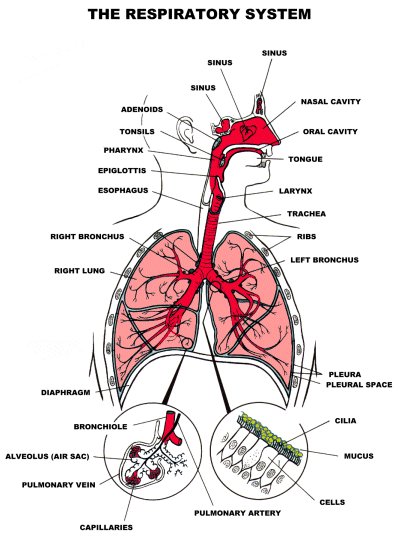
The SINUSES are hollow spaces in the bones of the head. Small openings connect them to the nasal cavity. The functions they serve are not clearly understood, but include helping to regulate the temperature and humidity of air breathed in, as well as to lighten the bone structure of the head and to give resonance to the voice.
The NASAL CAVITY (nose) is the preferred entrance for outside air into the Respiratory System. The Turbinates heat and humidify the inhaled air close to body temperature and up to 99% of humidity (respectively), and provide 50% of the respiratory system’s resistance, crucial for the correct amount of expansion of lungs (the lung-nose reflex), by narrowing the nasal airway cavities to the right amount of air needed by the lungs – according to different physiologic needs, and changes surrounding climatic conditions. The Turbinates also ensure that the air current through the nose will flow in a smooth and regular pattern, gently curving itself round the contours of the erectable mucosal tissues. This is known as Laminar Airflow pattern.
When too much of the inferior turbinates are resected the airflow patterns turns into unstable and erratic, although much more air can enter the nose, it is dry cold and un-filtered air, and becomes increasingly more difficult to properly inflate the lungs. The nasal respiratory epithelium tissues are covered with cilia – hair like tissue, that forms a kind of protective blanket – that captures airborne, potentially hazardous particles and sweeps the debris with the mucous secretion towards the nasopharynx, where it is swallowed by the esophagus and digested in the acidic juices of the stomach. This is known as the mucociliary transport phenomena of “cilia beat“.
Air also enters through the ORAL CAVITY (mouth), especially in people who have a mouth-breathing habit or whose nasal passages may be temporarily obstructed, as by a cold. The ADENOIDS are overgrown lymph tissue at the top of the throat. The lymph system, consisting of nodes (knots of cells) and connecting vessels, carries fluid throughout the body. This system helps resist body infection by filtering out foreign matter, including germs, and producing cells (lymphocytes) to fight them. The TONSILS are lymph nodes in the wall of the pharynx that often become infected. They are part of the first line of the germ-fighting system of the body. When Chronically infected and hypertrophied, they are generally partially resected or removed. The PHARYNX (throat) collects incoming air from the nose and passes it downward to the trachea (windpipe). The EPIGLOTTIS is a flap of tissue that guards the entrance to the trachea, closing when anything is swallowed that should go into the esophagus and stomach. Thus preventing suffocation by inhaling food and other alien objects to the lungs.